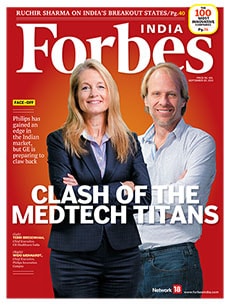
The Cloud and the Silver Lining in the India Growth Story
In this scenario, to expect any global company to be enthusiastic about India is asking for too much
If it hadn’t been for the recent dramatic collapse of the rupee and the negative domestic and international business sentiment associated with India, we would still have been in denial about how far we’ve fallen as an investment destination. Thanks to our political obsession with populist measures as opposed to creating an enabling environment for growth with equity, the Indian economy is headed towards our version of stagflation—decelerating growth in a climate of high, and largely untamed, inflation.

In this scenario, to expect any global company to be enthusiastic about India is asking for too much. However, we were delighted to find that at least two of them—GE and Philips—have not only not given up on India, but are pushing hard for growth with innovative strategies. India is a tiny speck in both GE’s and Philips’s global sales horizon, but both have been successful in wangling investments out of their parent companies. As Terri Bresenham, chief executive of GE Healthcare, told Seema Singh of Forbes India: “I do the translation for the global office, make India’s case bigger… For most multinationals, India is not even 5 percent of their [total] revenue.” The same holds for Philips, which has invested in an Innovation Campus in Bangalore—and is ahead of GE in segments of the medtech market as a result.
Seema Singh, who got a ring-side view of what’s cooking behind the scenes in both GE and Philips, says that in this clash of the medtech titans, customers are benefiting hugely. Says she: “The GE-Philips rivalry is doing to medtech what the IT industry did to reduce the cost of enterprise computing. These technologies are like the iPhone, where the price remains the same, but features and capabilities of the machines go up with every release. Customers, both the direct ones (health care providers like hospitals) and the ultimate end-users (patients), are benefiting.”
When one moves from the micro-level sectoral stories of GE and Philips to the macro gloom, clearly the India story starts running into the sands. Forbes India was fortunate to manage an exclusive interview with Ruchir Sharma of Morgan Stanley Investment Management, who had both gloomy and hopeful things to say about us. The hopeful ones relate to the rise of several breakout Indian states, which are performing consistently above the national averages. The gloomy stuff relates to what he had to say about the performance of the Central government.
Taken together, this issue tells you both sides of the India story—a glass half-full, half-empty.
Best,
R Jagannathan
Editor-in-Chief, Forbes India
Email: r.jagannathan@network18online.com
Twitter id: @TheJaggi
(This story appears in the 20 September, 2013 issue of Forbes India. To visit our Archives, click here.)














